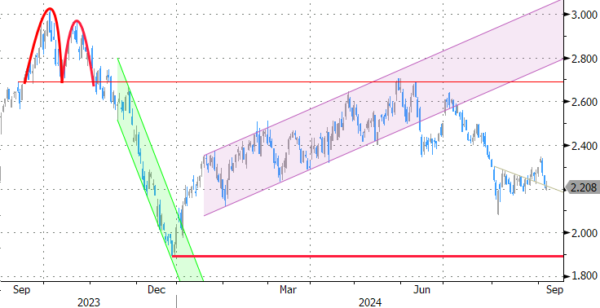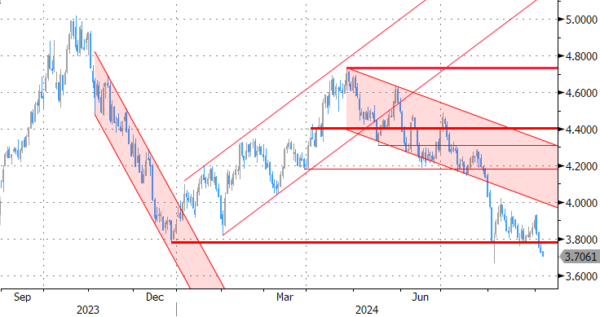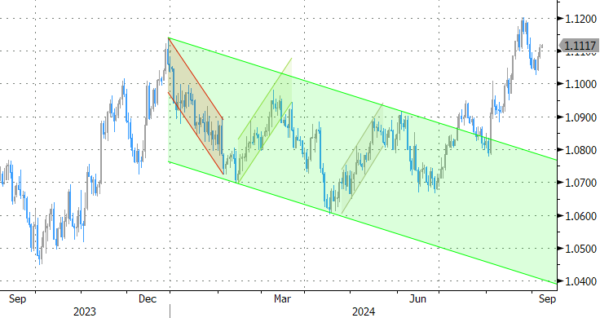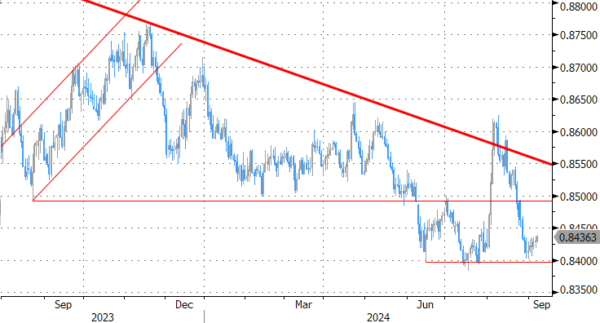Markets
The ADP job report yesterday produced the same price action seen in the wake of the US manufacturing ISM and US job openings. A below-consensus 99k for August and a downward revision to July’s report delivered another setback to yields. Outperformance at the front caused the 10-yr/2-yr spread to turn positive again only to be reversed after the publication of the August services ISM. Numbers were in line with expectations (headline 51.5 vs 51.4) but it sufficed for the likes of the 2-yr to cap previous losses somewhat. Maturities from 10-yr on finished at or even below the previous intraday lows. It meant the lowest closing level since July 2023. Eventual changes varied from -1.1 bp (2-yr) to -3.8 bps (30-yr). German yields eased 1.5-2.7 bps across the curve. Both data releases caused some intraday dollar volatility as well. The greenback lost ground against most peers. EUR/USD topped 1.11 with the previous YtD high around 1.12 looming. DXY finished just north of 101. USD/JPY’s close (143.45) was the lowest since early January. Oil (Brent $72.7/b, unchanged) wanted to but failed to gain on confirmed rumours that OPEC+ has agreed to delay a plan to gradually restore output due to the recent plunge in prices.
It’s P-day today. The official payrolls report’s importance is difficult to overstate. In the run-up SF Fed president Daly said that the Fed’s job right now is to keep the labour market about where it is now. She doesn’t yet know how big a rate cut is needed though. Goolsbee (Chicago) said he’s seeing mounting warning signs from the labor market and argued for multiple rate cuts soon. The consensus is for a 165k net job growth. Considering the recent developments, we think that’s a high-enough bar. Markets will also eyeball the unemployment rate. There’s a slight decline anticipated to 4.2%. Any miss in expectations – be it in job growth, the unemployment rate or, God forbid, both – will be looked at with Powell’s message of an “unwelcome weakening in the labour market” in mind. A set of disappointing data won’t just settle the debate on a 50 bps rate cut September 18. It will also shape expectations for similar-sized moves on the remaining meetings of this year in the “go fast, go hard” logic used to counter inflation applied to the labour market. Yields risk falling off a cliff, especially after breaking through recent support levels. The next references to look at are 3.55% (March 2023 low) and 3.45% (June 2022 interim high) for the 2-yr. The 10-yr may find some relief around 3.5% (June 2022 interim high). The dollar is prone for steep losses. EUR/USD 1.1139 won’t last long as dollar support. The EUR/USD YtD high of 1.12 serves as intermediate support ahead of 1.1274.
News & Views
At the press conference following Wednesday’s policy decision of the Polish National Bank (NBP), governor Glapinski slightly eased its previous assessment that NBP would only be able to cut interest rates in 2026 at the earliest. He indicated that the NBP could come in a position to start discussing interest rate cuts next year. However for now, the expected path of inflation remains too high. The NBP governor expects inflation to be around 5.0% at the end of the year. In addition, price growth still might increase early next year as measures to shield consumers for price rises will expire. Only when inflation stabilizes and there is a projected decline in the next quarters, the NBP will be able to start discussing rate cuts. Glapinski indicated that such scenario might materialize after Q2 next year. In a positive scenario it might occur after the Mach CPI projections. In any case, he expects a cautious start (25 bps) and the NBP won’t announce an easing cycle already at the time. Glapinski also still sees the government budget as being loose, which is a risk for the disinflation process. EUR/PLN holds at tight range between 4.26 and 4.30.
July data on Japanese household spending published this morning disappointed. Real spending was only 0.1% higher compared to the same month last year. Markets expected a rebound to 1.2% Y/Y. Nominal spending rose 3.3% Y/Y. In a monthly perspective spending even declined 1.7%. Today’s data indicate that Japanese consumers are relucted to spend even as real wages are moving into positive territory. Yesterday, July labour cash earnings data materially surpassed market expectations. For now, we don’t think these data will change the BOJ’s intention to normalize policy further. The yen this morning remains well bid, with USD/JPY (142.55) closing in on the ‘spike’ levels reached at the risk-off early August.
Graphs
GE 10y yield
The ECB cut policy rates by 25 bps in June and will likely do so again in September. Stubborn inflation (core, services) warrants a cautious approach on follow-up moves. Markets price in two to three more cuts for 2024 as disappointing US and unconvincing EMU activity data rolled in, dragging the long end of the curve down. The levels set in the wake of the August market meltdown for the time being serves as support.
US 10y yield
The Fed in its July meeting paved the way for a first cut in September. It turned attentive to risks to the both sides of its dual mandate as the economy is moving to a better in to balance. The pivot weakened the technical picture in US yields. A string of weak eco data pushed and kept the 10-yr sub 4%. Markets increasingly add to 2024 cut bets with more than one jumbo-sized cut gaining traction.
EUR/USD
EUR/USD moved above the 1.09 resistance area as the dollar lost interest rate support at stealth pace. US recession risks and bets on fast and large (50 bps) rate cuts trump traditional safe haven (recessionary) flows into USD. EUR/USD 1.12 was tested but survived. A (technical) dollar comeback had no strong legs. The greenback looks vulnerable.
EUR/GBP
The BoE delivered a hawkish cut in August. Policy restrictiveness will be further unwound gradually on a pace determined by a broad range of data. The strategy similar to the ECB’s balances out EUR/GBP in a monetary perspective. Recent better UK activity data and a cautious assessment of BoE’s Bailey at Jackson Hole are pushing EUR/GBP lower in the 0.84/0.086 range.

















